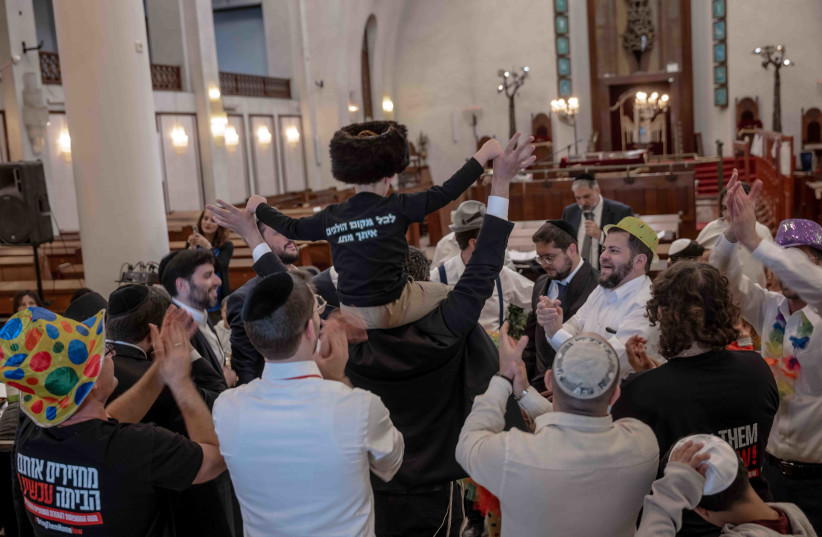The day was a collection of complex highs and lows. After the initial hugs and joyous greetings, the mood turned slightly, as if some of the family members suddenly felt guilty for these moments of happiness.
Standing to the side was Adi Pinto, aunt of Jonathan Samerano, murdered by Hamas terrorists on Oct. 7. Camera footage shows his body being grabbed by a social worker working for UNRWA and taken into Gaza. Pinto and other family members have been vocal in their demands for the world to stop funding UNRWA.
Pinto also insists that the bodies of all murdered Israelis held by Hamas should be included in any hostage deal.
“We don’t want to be the next Arad family,” she said, referring to weapons system officer Lt.-Col. Ron Arad, captured by the enemy in 1986, his body never found.
Joining her was Ayelet, Jonathan’s mother, who skirted questions about her son. Looking around at the crowd, she noted: “We need more of these events. They bring us together as a people.”
A row of women, all related to Omer Shem Tov and decked out in Purim hats, occupied one of the synagogue’s pews – among them his grandmother Sarah Eshkenazi, his aunt Suzi Sadi, and his mother, Shelley.

“The last few months have been a roller coaster of emotions,” said Suzi. “We try to embrace the joy of the holiday, but it’s so hard. Passover is just around the corner. We have to believe that they’ll come home.”
She paused, before stating adamantly: “They will be home.”
THE READING of Megillat Esther began. Some held little booklets handed out before the service, whispering their prayers in fervor. Others sat deep in thought.
Cute kids in fancy dress walked up and down the rows or clambered over the seats. It was hard to tell who they “belonged” to. Everyone treated them like their own – pulling them in for a hug, smiling at them, or ruffling their hair as they walked by.
A festive meal followed and a singer launched into Purim songs, and the people of Kesher Yehudi were on their feet, pulling the hostage families to join in the dancing. While some politely shook their heads, they could be seen tapping along to the music from their chairs. Yet many of them, including Omer Shem Tov’s family, got caught up in the joy of the holiday, dancing around in the circles formed and swaying to the music with their haredi hosts.
“Isn’t this wonderful?” asked Leah Hecht of Kesher Yehudi, who had attended the two previous events and was bowled over by the connections created.
Were not so different, you and I
“I realized there just how similar we are,” she said. “Our differences are so minor. We are all Jewish. We all want the same things. We all have the same values. All we need to do is talk to each other.”
While she understood the initial skepticism felt by the families before attending the weekend events, she also addressed the concerns of the haredi participants. “We were scared to say something insensitive, scared that something would come across as too ‘religious,’” she said. “We don’t want to convert people. We truly just want to break down the walls.”
Kesher Yehudi has spearheaded numerous initiatives to dismantle these barriers. For many years, its main work has been to bring haredim into secular mechinot (pre-army programs) as peers so participants can learn from one another and become friends. Since the start of the war, requests from mechinot to integrate haredi youth have doubled, as more and more people understand that if unity as a nation is truly important to us, we need to take action.
When asked about other things the average man or woman on the street can do to build bridges, Hecht talked about another initiative. Kesher Yehudi matches people of similar ages but from completely different backgrounds so that they can speak weekly on the phone, learn about their lifestyles, and become friends.
“It becomes more difficult to hate the ‘enemy’ when it has a name and a face,” she explained.
After several hours of eating, dancing, and megillah reading, the families hugged their hosts goodbye with warmth and emotion before returning to Hostages Square and their brutal reality of fighting for the return of their loved ones.
Schneider summed up the Purim feast: “I asked one of the families honestly how they found the strength to celebrate when their child was in the tunnels of Gaza,” she said. “They told me that they could still find happiness in the day. They were happy to be part of the Jewish people.”
